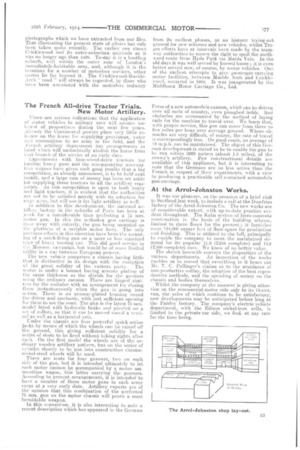The French All-drive Tractor Trials.
Page 3

If you've noticed an error in this article please click here to report it so we can fix it.
New Motor Artillery.
There are serious indications that the application of motor vehicles to military uses will assume unheard of proportions during the next few years. Already the Continental powers place very little re-hence on the horse for supplying provisions, water aml ammunition to an army in the field, and the Crench artillery &pediment has arrangements in hand which will undoubtedly abolish the horse from that branch of the service at an early date.
Experiments with four-wheel-drive tractors tor hauling heavy guns and the accompanying anneuniti on wagons have given smell good results that a big competition, as already announced, is to be held next Month, and a large sum of money has been eel aside or supplying these tractors to all the artillery regi,rilerits. As this competition is open to both heavy tittl light tractors, it is evident that the authorities are rrot to be satisfied merely with its adoption for eif`gP gems, but will use it for light artillery as well.
I it addition to this development, the national artillery factory in the suburbs of Paris has been at ‘N-orkfor a considerable time perfecting a 75 mm. Motor gun. In this the orthodox gun carriage is 'time; away with entirely, the gun being mounted on the platform of a suitable motor lorry. The only previous efforts in this direction have been the mounting of a quick-firing gun on a more or less standard type of heavy touring car. This did good service in He Momeca campaign, but would be of more limited utility in a war between European powers.
The new vehicle eomprises a chassis having little that is distinctive in its design with the exception
of the great solidity of the various parts. The motor is under a bonnet having armour plating of the same thickness as the shields for the gunners usiag the ordinary cannon. There are hinged shutters for the radiator with an arrangement for closing them instantaneously when the gun is going into aetion. There is an armour-plated housing round the driver and mechanic, with just sufficient opening for them to see the road. The gun is the latest 75 mm. model fitted with hydraulic brake and pivoted on a Set of rollers, so that it can be moved round a vertical as well as a horizontal axis.
Under the chassis are four' powerful quick action jacks by means of which the wheels can be raised off the ground, this giving sufficient solidity for a series of shots to be fired without taking sights after each. On the first model the wheels are of the ordinary wooden artillery pattern, but on the series of vehicles shortly to be put into construction chromeniekel-steel wheels will be used.
There are seats for four gunners, two on each side of the gun, but it is intended ultimately to let each motor cannon be accompanied by a motor ammunition wagon, this latter carrying the gunners. According to present arrangements, it is intended to have a number of these motor guns in each army corps at a very early date. Artillery experts are of the opinion that this combination of the perfected 75 mm. gun on the raptor chassis will prove a most fo rmi stable weapon. In this connection, it is also interesting to note a recent description which has appeared in the German
Press of a new automobile cannon, which can be driven over all sorts of country, even ploughed fields. Bad obstacles are surmounted by the method of laying rails for the machine to travel over. We learn that, with proper service, this gun can cover from three to five !idles per hour over average ground. Where obstacles are very difficult, or course, the rate of travel is correspondingly less. On good roads, an average of 1.8 m.p.h. can be maintained. The object of this German development is stated to be to enable the gun to be run within 3000 metres (about 1.8 miles), of the enemy's artillery. Few constructional details are available of this appliance, but it is interesting to note that the Germans are no less active than the French in respect of their experiments, with a view to producing a practicable self-contained automobile gun-carriage.
At the ArroL-Johnston Works.
It was our pleasure, on the occasion of a brief visit to Scotland last week, to include a call at the Dumfries factory of the skrrol-Johnston Co. The new works are of considerable extent, with up-to-date practice evident throughout. The Kahn system of ferro-concrete construction is the basis of the building scheme, limited to three floor's for the present; it furnishes some 12[,000 square feet of floor-space for production and finishing. This is utilized to the full, principally to enable the company to meet the maintained demand for its popular 11.9 (i285 complete) and 15.9 (R.360 cornpletO ears. We know of no better value.
The sketch herewith conveys the disposition of the various departments. An inspection of the works enables us to record that everything in it bears out Mr. T. C. Pullinger's claims as to the avoidance of non-productive outlay, the adoption of the best reproductive methods, and the spending of money on the chassis and bodies themselves.
Whilst the company at the moment is giving attention on the commercial-motor side only to its 15-c-wt, van, the sales of which continue to be satisfactory, new developments may be anticipated before long at the Paisley factory. The company's electric-vehicle department, with the Edison nickel-iron cells, is limited to the private-car side, we find, at any rate for the time being.


























